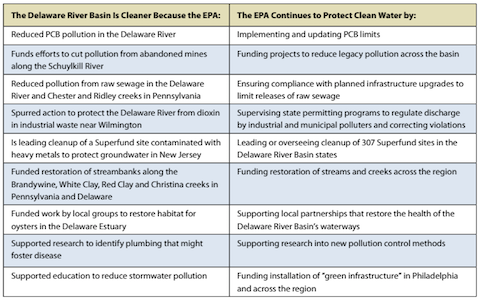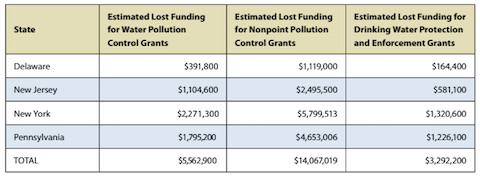Rough Waters Ahead
The Delaware River is critical to the health and welfare of our families, our communities, and wildlife. The longest undammed river east of the Mississippi, the Delaware traverses four states – New York, Pennsylvania, New Jersey and Delaware – and its watershed supplies drinking water to more than 15 million people, including residents of New York City and Philadelphia.
The Delaware River is critical to the health and welfare of our families, our communities, and wildlife. The longest undammed river east of the Mississippi, the Delaware traverses four states – New York, Pennsylvania, New Jersey and Delaware – and its watershed supplies drinking water to more than 15 million people, including residents of New York City and Philadelphia.
Today, much of the Delaware River is clean enough for fishing and swimming. But, it wasn’t always that way. In the 1950s, the urban portion of the Delaware River was one of the most polluted stretches of river in the world. It took the dedicated work of local, state and federal governments – along with local residents – to turn the tide and begin the long process of restoring the Delaware to health.
The U.S. Environmental Protection Agency has been essential to those efforts – supporting and working with state and local efforts to keep pollution out of our waterways, hold polluters accountable, restore degraded waterways to health, and study and monitor the Delaware River Basin to ensure its future health and safety.
That progress is now in jeopardy. The Trump administration has proposed deep and devastating cuts to the EPA’s budget. Even if the president’s proposed cuts are scaled back by Congress, they would still have profound negative impacts on the agency’s ability to deter pollution from industrial facilities, agriculture, sewage treatment plants, runoff and other sources, while undercutting efforts to restore iconic waterbodies such as the Delaware River.
America can’t go back to the bad old days. We need a strong EPA with sufficient resources to support local cleanup efforts and partner with states and communities to protect and restore the Delaware River Basin.
The Delaware River Basin is being protected and restored to health with funding and effort from the EPA. The EPA has worked to:
- Keep pollution out of our waterways: Decades of industrial activity polluted the Delaware River and its tributaries with polychlorinated biphenyls (PCBs), cancer-causing chemicals that also affect the reproductive and immune systems. Since the 1980s, officials in Delaware River states have warned residents to limit their consumption of fish caught in some sections of the river due to PCB contamination. The EPA and state agencies have worked for more than a decade to establish new standards for PCB discharges to the river. Thanks to those standards and cleanup efforts at former industrial sites, the 10 largest polluters reduced PCB pollution by 71 percent between 2005 and 2013. To continue cutting PCB pollution in the Delaware River, the EPA’s regional offices are working with local agencies to update PCB limits.
- Hold polluters accountable: The EPA is charged with ensuring that the nation’s environmental laws are properly enforced, acting as a deterrent to would-be polluters. DuPont’s Titanium Technologies facility near Wilmington, Delaware, used millions of pounds of chlorine to process ore into white pigment—and generated toxic wastes including a 500,000-ton pile of dioxin-laced waste at the site. In the course of addressing the pile of waste, the EPA discovered the facility had failed to report its pollution and had committed numerous Clean Water Act violations. EPA and the Delaware Department of Natural Resources reached an agreement with DuPont in which DuPont agreed to pay a $500,000 penalty andseal the waste pile, reducing the chances that harmful pollution will reach the waterway. The EPA is assisting Delaware state agencies as they oversee cleanup of the pile.
- Restore waterways to health: The Christina River supplies drinking water to 60 percent of Delaware’s population. As with all rivers, the quality of the water often depends on what happens upstream. In 2003, a $1 million grant from the EPA’s Watershed Initiative enabled the Christina Basin Clean Water Partnership to undertake restoration of multiple tributaries to fishable, swimmable and drinkable status. For every federal dollar invested in the project, the Partnership leveraged more than two dollars from local sources, which allowed them to expand beyond their original restoration plans, such as reforesting 9,000 feet of streambanks instead of the planned 6,000 feet.
- Conduct research and educate the public: EPA-funded research provides the data and tools local officials, scientists and the public need to protect waterways and human health. An EPA-funded research team at Drexel University, for example, is developing a web-based simulation tool that would help give water utilities and facilities managers the information they need to keep drinking water safe.
Table ES-1. How Clean Water in the Delaware River Basin Depends on the EPA

The Trump administration’s proposed cuts to the EPA budget put these and other critical functions in danger – threatening the future health of the Delaware River.
● Under the administration’s proposal, water-related programs run directly by the EPA would be slashed by 34 percent, hobbling efforts to prevent runoff pollution, monitor water quality, establish pollution limits, protect watersheds and wetlands, and pursue polluters.
● In addition, many federal grants from the EPA to state governments for clean water would be slashed by 30 percent or more – making it more difficult for already cash-strapped state agencies to do their jobs and delaying important locally led cleanup efforts. For example, the proposed budget would end grants to state governments and tribal agencies to address pollution from farms, stormwater runoff and other dispersed sources.
● Research and development funding would be cut by 47 percent, limiting support for scientists, residents and local communities trying to understand the ever-changing threats facing their waterways. For instance, the EPA’s Safe and Sustainable Water Resources research program, which supports science and technology research to protect drinking water, would be cut by more than a third.
● Overall, the EPA budget would be reduced by 31 percent.
Even if Congress makes some of these budget cuts less drastic, the Delaware River Basin will still suffer without full funding of EPA programs.
Table ES-2. Estimated EPA Grant Funding Losses to Delaware River Basin States if Trump Administration’s Proposed Budget Is Enacted (table shows selected programs)*

Note: Estimates are calculated assuming EPA budget cuts affect all states by the same percentage. Reductions are based on grants from most recent fiscal year. “Water pollution control grants” are Section 106 grants, slated for a 30 percent cut. “Nonpoint pollution control grants” are Section 319 grants, cut entirely in the administration’s proposed budget. “Drinking water protection and enforcement grants” are Public Water System Supervision grants, cut by 30 percent.
The job of cleaning up and protecting the Delaware River basin is not done. Continuing pollution from sewer systems, industrial facilities and runoff – along with the emergence of new pollution threats from new classes of industrial and household chemicals – call for continued vigilance and action. Only a well-funded EPA can continue the region’s legacy of progress in cleaning up the Delaware River Basin and ensure that its streams and rivers are healthy and safe for us and future generations to enjoy.
*Correction (11/28/17): Information in Table ES-2 and Table 1 has been updated. “Estimated Lost Funding for Water Pollution Control Grants” has been corrected for New York and Pennsylvania, and the total in that column updated. As a result of a data analysis error, the original version of the report underestimated potential lost funding in those two states.
